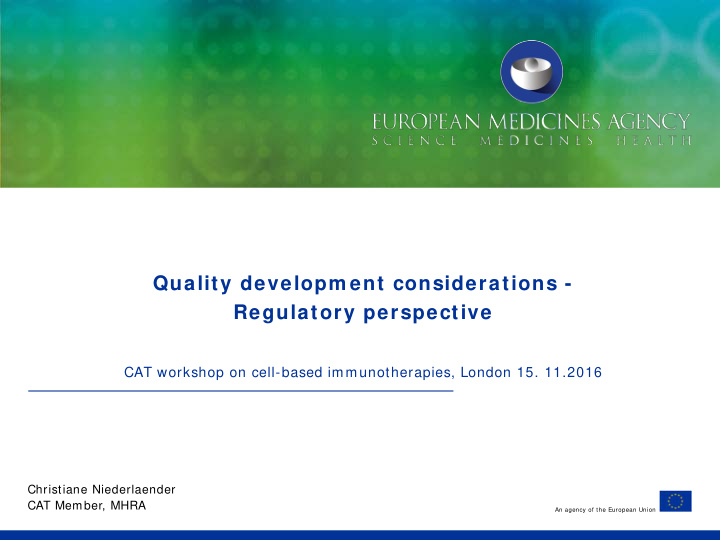



Quality developm ent considerations - Regulatory perspective CAT workshop on cell-based immunotherapies, London 15. 11.2016 Christiane Niederlaender CAT Member, MHRA An agency of the European Union
Genetically modified, cell-based cancer immunotherapies GOAL modify immune cells to attack and clear tumor cells CAR-T –cells, TCRs, NKs / TANKs, TRUCKS,… . APPROACH MEANS viral vectors, plasmids, gene editing several products in clinical studies, but new STATUS technologies evolve fast more and more complex products, multiple FUTURE modifications, off the shelf/ allogeneic products safety switches, inductors, in vivo GE? 1
Cell-based cancer immunotherapies (GTMPs!) Apheresis Vector/GT/ GE material production Cell preparation Vector/GT/ GE Gene transfer material testing Cell expansion Formulation, storage Quality needs to be built-in within every step of the manufacturing process! 2
Apheresis - window for collection and information on pre-treatments + possible impact on the cellular starting material - donor testing, autologous vs. allogeneic - method of cell collection should collection systems be standardised or validate multiple approaches? - acceptance criteria for the apheresis preparation - controlled transportation to the manufacturing site; 3
Cell preparation - which cells - cell isolation (PBMCs) and enrichment, choice of the method - activation of the cells required for signalling and transduction - issues related to scale-up and automisation comparability suitable, specific markers to control the cell type product-related im purities, variability quality specifications for the cells impurities, e.g. removal of beads - im pact on the quality of the product critical in-process parameters to be identified early on - direct genetic manipulation or cryopreservation for later use 4
Vector/ GT/GE material production and testing - Considerations for the ‘therapeutic sequence’ must be justified - Starting material considerations - cell bank/ viral seed qualifications - gene editing technologies: off-target effects - viral safety and microbiological purity of starting and raw materials; - release testing for vectors- including identity, titer, potency, purity 5
Gene transfer - transduction, electroporation, gene editing… - generation of control cells e.g. for microbiological purity testing? - transduction / gene editing efficiency, - need to demonstrate the genetic modification(s) are correct and overall genetic stability - check persistence and genetic stability in patients 6
Cell expansion • multiple expansion methods available, including specific process for gene-edited cells • culture conditions and quality of the biological raw materials • time in culture (max PDLs) to be justified based on product quality • expansion process to be defined and validated 7
Formulation, storage - formulation should not change the safety and efficacy of the product - specific formulation studies may be needed for longer storage period - quality and number of cells after storage - considerations for frozen cells 8
Specific issues concerning the m anufacturing process - GMP and aseptic processing (GMP guideline for ATMPs) - Vector Quality (draft Gene Therapy guideline) - quality of critical raw materials (Ph.Eur. General text on biological raw materials for production of cell and gene therapy products) - ability of the process to give clinically meaningful cell numbers - mitigation of variability/ consistency, validation of the process limits for variability - process changes and comparability 9
Quality control - control strategy to be planned early on taking into consideration the limitations, but also all quality attributes that need to be controlled - level of characterization to define QC tests - impurities (product/ process-related), purity and number of the intended cell type, viability; microbiological purity - identity testing - potency testing - stability testing - suitability of analytical methods and validation of key assays 10
Potency testing - should follow mode of action; simple e.g. marker-based assays can be accepted for release provided that a more thorough assay package is available for process validation & comparability testing - functional, cell-based assays challenging, if require materials from the donor for the assay (e.g. to demonstrate cytotoxicity) - one option would be to have a functional (PoC) assay for characterisation (with 1-2 donor cells) and use it to correlate other methods need a negative control to compare to the activation caused by external factors (cytokines, aAPCs… ) - possible release/ comparability methods could be based on cell-surface markers, expression of the CAR-construct, substances secreted by the activated T-cells,… - sensitivity (to detect subpotent batches) and specificity 11
Com parability testing - where changes made to the production process, materials, etc. could lead to clinically significant changes in the final product - critical parameters - level of testing (release + characterisation), stability testing - when would quality data alone be sufficient to demonstrate comparability of cells 12
Points for discussion • apheresis: how to mitigate variability? should collection systems be standardised? • cell bank/ viral seed qualifications: control cells e.g. for microbiological purity testing? • QC and release criteria, potency testing • how to demonstrate comparability? • Requirements for viral vector and finished medicinal product analysis regarding integration and specificity 13
Thank nk y you ou f for or you our a atte ttent ntion! on! 14
Recommend
More recommend